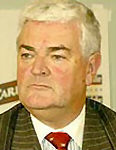



|
 |

|
|
|
|||
|
Y Deg Disglair: Oes yna ddewis arall? / Super 10: Is there an alternative? Saesneg / English  Mae’n ddiddorol sylwi ar yr ymatebion i arolwg gwefan welsh-premier.com i’r hyn a elwir yn Super 10. Er fod 29% wedi datgan fod y cynigion newydd yn dda i bêl-droed Cymru mae 26% o blaid cadw at y drefn bresennol. Dywed 26% fod gormod o gemau yn erbyn yr un timau yn y drefn newydd ac mae 19% yn ystyried y bydd y clybiau yn yr ail adran yn cael eu gwthio o’r neilltu. Nid yw’r arolwg yn dangos cefnogaeth frwd iawn i gynlluniau Bwrdd y Gynghrair. Mae’n ddiddorol sylwi ar yr ymatebion i arolwg gwefan welsh-premier.com i’r hyn a elwir yn Super 10. Er fod 29% wedi datgan fod y cynigion newydd yn dda i bêl-droed Cymru mae 26% o blaid cadw at y drefn bresennol. Dywed 26% fod gormod o gemau yn erbyn yr un timau yn y drefn newydd ac mae 19% yn ystyried y bydd y clybiau yn yr ail adran yn cael eu gwthio o’r neilltu. Nid yw’r arolwg yn dangos cefnogaeth frwd iawn i gynlluniau Bwrdd y Gynghrair.Mae’n rhaid bod amheuon mawr am allu’r ail adran i oroesi a hynny am rhesymau daearyddol yn unig gan y bydd mwyafrif y clybiau yn yr adran hon o’r gogledd neu’r canolbarth sydd yn golygu bydd yr un neu ddau o glybiau’r de yn treulio amser ac arian afresymol yn teithio. Rhaid hefyd tybio y bydd yr arian ar gael yn cael ei gyfeirio at y 10 clwb uwch gan roi dyfodol y 10 arall yn y fantol. Dros gyfnod o amser bydd yr ail adran yn gwanio gyda rhai yn mynd i’r wal. Bydd pêl-droed ar y lefel yma yng Nghymru i lawr i ddeg clwb â’r potensial i lwyddo (efallai llai), a wedyn anialwch o glybiau o safon isel heb uchelgais na unlle i anelu ato. Nid yw hyn yn fanteisiol yn y tymor hir i bêl-droed yng Nghymru gan fod profiad yn dangos gall clybiau sy’n codi fel madarch ar gefn cefnogaeth ariannol un dyn yr un mor sydyn ddiflannu mewn cwmwl o lwch. Yn y cyfamser bydd clybiau, sydd a’u seiliau yn gadarn yn y gymuned ac yn asgwrn cefn y gêm, yn cael eu gwanhau neu yn cael eu gorfodi i chwarae ar lefel llawer is. Rhoddwyd rhy ychydig o sylw i gynlluniau eraill posibl. Mae llawer o gynghreiriau cenedlaethol mewn gwledydd bychan, lle mae yna amrywiaeth eang yn safon y clybiau o fewn yr un gynghrair, wedi edrych i gyfeiriad rhannu’r tymor yn ddau –split season. Trwy rhannu’r tymor bydd yn bosib cynnwys mwy o glybiau mewn un adran – hyd at 16. Bydd hyn yn caniatáu i glybiau ddatblygu tra ar yr un pryd yn creu y cyfle i’r cryfaf ffurfio cynghrair tu fewn i’r gynghrair. Os bydd gan y gynghrair 16 o glybiau byddant yn chwarae eu gilydd ddwywaith yn hanner cyntaf y tymor. Yna yn ail ran y tymor bydd yr 8 uchaf yn chwarae eu gilydd ddwywaith i benderfynu’r bencampwriaeth tra fod yr 8 isaf yn chwarae eu gilydd i setlo pwy sy’n mynd i lawr. Bydd y pwyntiau a enillwyd yn yr hanner cyntaf yn cael eu cario drosodd i’r ail gan gyfrannu at y cyfanswm terfynol. Bydd rhai yn gwrthwynebu am fod yna ormod o gemau - 44 mewn tymor yn lle 36 yn y Super 10. Ond gellir torri yn ôl ar y nifer drwy gael gwared o Gwpan y Gynghrair sydd, er y newidiadau cyson yn y fformat, wedi aros yr un mor amhoblogaidd yn llygaid y cefnogwyr. Os cyflwynir y newidiadau yma yr un pryd a newid i amseriad y tymor mae’n bosibl sicrhau fod diweddglo’r tymor yn cael ei chwarae pan fydd Uwch Gynghrair Lloegr wedi gorffen. Mae fersiwn Gweriniaeth Iwerddon o bêl-droed haf yn cychwyn ac yn gorffen pan fod Uwch Gynghrair Lloegr yn dal yn ei anterth. Gellir sicrhau hyn drwy ddechrau’r tymor dyweder yng nghanol Medi a mynd ymlaen a chymryd toriad gaeaf yn dilyn y gemau traddodiadol o gwmpas Nadolig a Dydd Calan. Ar ôl toriad bydd y gemau yn mynd ymlaen tan dywedir canol Gorffennaf er mwyn i’r diweddglo beidio bod yr un pryd ac Uwch Gynghrair Lloegr a chyfle felly am well torfeydd. Mae yna hefyd fanteision i glybiau fydd yn chwarae yn Ewrop gan fydd y gemau rhagbrofol yn digwydd pan fydd y gynghrair yn dal i fynd yn ei flaen. Mantais arall –ni fydd y drefn yma yn effeithio cymaint ar weddill y pyramid ac os na fyddai’n llwyddo, mae’n dal yn bosib wedyn mynd yn ôl at yr hen drefn. Mae angen i UGC gynnal arolwg llawer ehangach am ddyfodol y gynghrair a dylai hyn gynnwys holi cefnogwyr. Rhy hawdd o lawer ydy’r opsiwn Deg Disglair a dydy o chwaith ddim yn caniatáu datblygiad i’r dyfodol i’r mwyafrif y clybiau. Gareth Williams Barn cyfrannwr yw'r syniadau a fynegir yma ac nid ydynt o reidrwydd yn adlewyrchu barn y clwb. Super 10: Is there an alternative?  It is interesting to note the responses to the welsh-premier.com poll on the so called Super-10 proposals. Whereas 29% have indicated that they believe that the new proposals would be good for Welsh football, 26% favoured the status quo. 26% also feel that the new arrangements will mean too many games against the same opposition while 19% consider that the 10 clubs in the second tier will be sidelined. This hardly represents overwhelming support for the League Board’s plans. It is interesting to note the responses to the welsh-premier.com poll on the so called Super-10 proposals. Whereas 29% have indicated that they believe that the new proposals would be good for Welsh football, 26% favoured the status quo. 26% also feel that the new arrangements will mean too many games against the same opposition while 19% consider that the 10 clubs in the second tier will be sidelined. This hardly represents overwhelming support for the League Board’s plans.There must be grave doubts about the viability of the second tier for geographical reasons alone and as the majority of the clubs involved are likely to be from north and mid Wales the one or two southern clubs involved will be spending an unreasonable amount of time and money travelling. It must also be concluded that the money available will be directed towards the top 10 clubs putting the viability of the others in doubt. Over a period of time the second tier will dwindle with some clubs undoubtedly going to the wall. Welsh football at this level will be left with 10 clubs (or possibly fewer) that are successful and then a desert of sub-standard clubs without ambition and nowhere to go. This is not for the long term good of Welsh football as experience tells us that clubs that rise like a mushroom on the back of one man’s financial support can just as easily disappear in a cloud of dust. In the meantime the community based clubs, who are the backbone of the game, will have been either destroyed or forced to operate at a far lower level. Too little consideration has been given to possible alternatives. Many smaller leagues in a similar situation, where because of the size of the country the clubs within the same league vary greatly in their relative strengths, have used a version of the split season. By having a split season it is possible to include more teams in the league –up to 16. This will allow clubs the chance to develop and at the same time give the top sides their league within a league. If the league has 16 clubs then during the first part of the season each team will play each other twice. In the second part of the season the Top 8 clubs will play each other twice to decide the championship while the Lower 8 clubs will also play each other twice to decide the relegation issues. Points gained in the first part of the split season should carry over to the second part and contribute to the final shake out. Some might be put off by the number of games involved, 44 in the season compared to 36 in the Super 10. The increase in the number of fixtures can be counteracted by getting rid of the League Cu, which, despite its many reincarnations, remains as unpopular as ever. If we combine these changes with a switch in the timing of the season then it could be arranged that the concluding part of the WPL season takes place when the English Premier league has completed its season. The Republic of Ireland version of summer football starts and finishes when the Premier League is in full flow. This can be achieved by starting the season say mid September with a winter break after the Boxing Day and New Year’s Day matches. The season should then end in mid July which means that the business end of the season takes place without competition from the English Premier League and will give an opportunity for increased attendances. There are also advantages for clubs playing in Europe as the preliminary matches will not be played during our close season. It also has the advantage of not being out of joint with the rest of the pyramid and should it not work out then it is possible to switch back to the traditional August – April season. The WPL need to conduct a far wider survey on the future of the league and it should include seeking the views of supporters. The Super 10 option is too simplistic and does not provide for the future development of the game in Wales. Gareth Williams The views expressed are those of the contributor and do not necessarily reflect the views of the club. |

|
||
|
|
|||